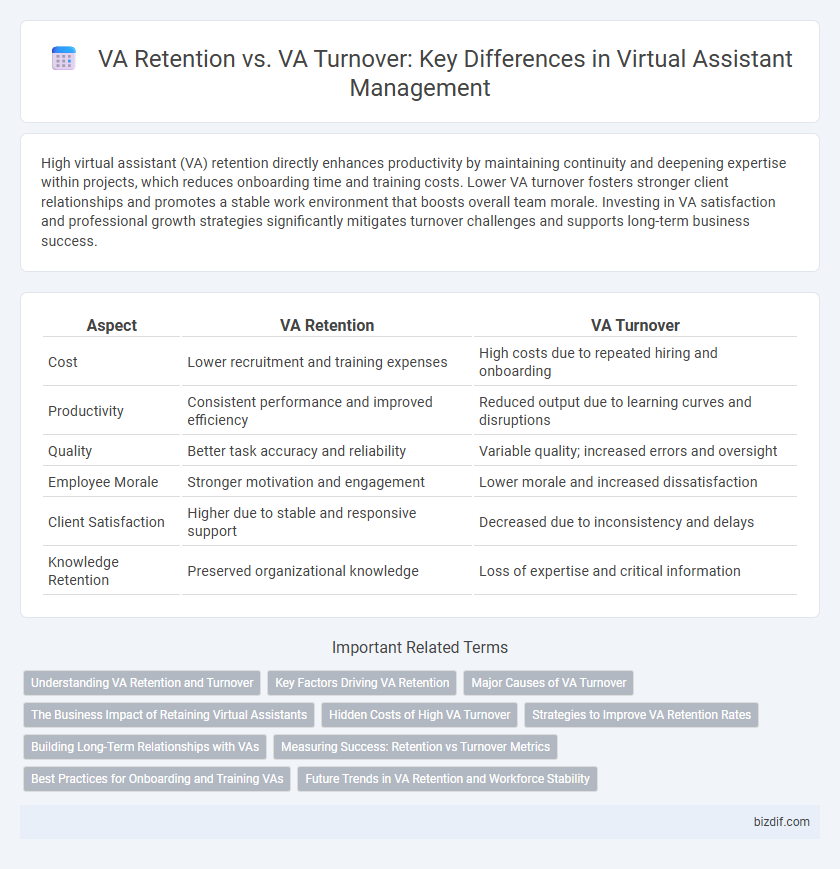High virtual assistant (VA) retention directly enhances productivity by maintaining continuity and deepening expertise within projects, which reduces onboarding time and training costs. Lower VA turnover fosters stronger client relationships and promotes a stable work environment that boosts overall team morale. Investing in VA satisfaction and professional growth strategies significantly mitigates turnover challenges and supports long-term business success.
Table of Comparison
| Aspect | VA Retention | VA Turnover |
|---|---|---|
| Cost | Lower recruitment and training expenses | High costs due to repeated hiring and onboarding |
| Productivity | Consistent performance and improved efficiency | Reduced output due to learning curves and disruptions |
| Quality | Better task accuracy and reliability | Variable quality; increased errors and oversight |
| Employee Morale | Stronger motivation and engagement | Lower morale and increased dissatisfaction |
| Client Satisfaction | Higher due to stable and responsive support | Decreased due to inconsistency and delays |
| Knowledge Retention | Preserved organizational knowledge | Loss of expertise and critical information |
Understanding VA Retention and Turnover
VA retention reflects the percentage of virtual assistants who remain employed over a given period, indicating stability and job satisfaction. High VA turnover signals challenges such as inadequate compensation, lack of engagement, or poor management, leading to increased recruitment and training costs. Monitoring retention rates allows businesses to implement targeted strategies to improve VA satisfaction, productivity, and long-term commitment.
Key Factors Driving VA Retention
High VA retention is driven by clear communication, ongoing training, and competitive compensation, which enhance job satisfaction and professional growth. Providing flexible work schedules and supportive management fosters a positive work environment that reduces burnout and increases loyalty. Access to advanced tools and regular feedback ensures VAs remain engaged and motivated, directly lowering turnover rates.
Major Causes of VA Turnover
High VA turnover is often driven by limited career growth opportunities, inadequate compensation, and lack of recognition in virtual assistant roles. Poor communication and unclear job expectations contribute significantly to dissatisfaction, prompting VAs to seek more supportive work environments. Addressing these major causes is crucial for improving VA retention rates and sustaining a motivated virtual workforce.
The Business Impact of Retaining Virtual Assistants
High retention of virtual assistants significantly reduces recruitment and training expenses, enhancing overall operational efficiency. Consistent VA tenure improves client satisfaction through deeper understanding of business processes and stronger professional relationships. Lower turnover rates foster knowledge continuity and boost productivity, driving sustainable business growth.
Hidden Costs of High VA Turnover
High virtual assistant (VA) turnover incurs hidden costs such as lost productivity, increased recruitment expenses, and extended training periods that disrupt business continuity. Frequent turnover also impacts team morale and the consistency of client relationships, reducing overall operational efficiency. Prioritizing VA retention minimizes these costs by fostering experienced, committed virtual assistants who contribute to sustained business growth.
Strategies to Improve VA Retention Rates
Implementing comprehensive onboarding programs and continuous training significantly enhances virtual assistant retention rates by boosting job satisfaction and skill development. Offering competitive compensation and clear career progression paths reduces VA turnover by increasing motivation and long-term commitment. Establishing regular feedback mechanisms and fostering a supportive remote work culture promotes engagement and loyalty among virtual assistants.
Building Long-Term Relationships with VAs
Building long-term relationships with virtual assistants significantly improves VA retention by fostering trust, clear communication, and mutual respect, reducing turnover rates. Consistent feedback and professional development opportunities enhance engagement and loyalty, making virtual assistants more invested in their roles. Implementing supportive onboarding processes and recognizing achievements creates a positive work environment that encourages virtual assistants to stay longer.
Measuring Success: Retention vs Turnover Metrics
Measuring success in virtual assistant management hinges on analyzing retention and turnover metrics, where high retention rates indicate strong job satisfaction and operational stability. Tracking turnover rates, including voluntary and involuntary separations, helps identify gaps in training, workload, or workplace culture. Effective use of these metrics enables businesses to optimize hiring strategies, improve virtual assistant performance, and reduce costly churn.
Best Practices for Onboarding and Training VAs
Effective onboarding and training programs significantly reduce virtual assistant (VA) turnover by fostering engagement and skill development from the start. Structured training modules, clear communication channels, and continuous feedback mechanisms enhance VA retention rates by aligning expectations and improving job satisfaction. Investing in personalized onboarding experiences and ongoing professional development creates a loyal VA workforce, minimizing recruitment costs and ensuring consistent performance.
Future Trends in VA Retention and Workforce Stability
Emerging technologies such as AI integration and advanced analytics are poised to revolutionize virtual assistant retention by enhancing personalized support and predicting turnover risks. Companies leveraging continuous learning platforms and flexible work models report higher workforce stability and reduced VA turnover rates. Future trends indicate a shift towards hybrid AI-human collaboration, fostering long-term engagement and optimizing operational efficiency in virtual assistant teams.
VA retention vs VA turnover Infographic

 bizdif.com
bizdif.com